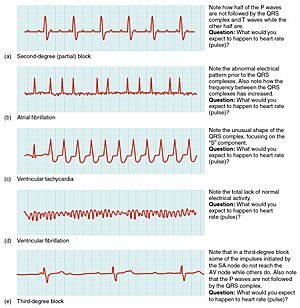Cardiac arrhythmia facts for kids

Your heart is an amazing pump! It beats all the time to send blood around your body. Sometimes, the heart's rhythm can get a little mixed up. This is called a cardiac arrhythmia or an irregular heartbeat. It means your heart isn't beating in its usual, steady way.
Contents
What is an Irregular Heartbeat?
An irregular heartbeat happens when your heart's electrical signals don't work perfectly. These signals tell your heart muscles when to squeeze and relax. When they are off, your heart might beat too fast, too slow, or in an uneven pattern.
How Does Your Heart Beat?
Your heart has its own natural pacemaker. This is a special group of cells that sends out electrical signals. These signals travel through your heart, making it contract and pump blood. A normal heartbeat is steady and regular, like a drum keeping a perfect beat.
Types of Irregular Heartbeats
There are different ways a heartbeat can be irregular:
- Too Fast (Tachycardia): Sometimes, your heart beats much faster than it should. It might feel like your heart is racing. This can happen during exercise, but it's an arrhythmia if it happens when you're resting.
- Too Slow (Bradycardia): Other times, your heart beats too slowly. This means it's not pumping enough blood to your body.
- Uneven Rhythm: Your heart might beat in an irregular pattern. It could skip a beat, or add an extra beat. This can make your heart feel like it's fluttering or thumping.
What Causes Them?
Many things can cause an irregular heartbeat. Sometimes, it's just a normal change that doesn't mean anything serious. Other times, it can be caused by:
- Stress or anxiety
- Too much caffeine or certain energy drinks
- Some medicines
- Being sick with a fever
- Problems with the heart itself, like if it's been damaged
- Conditions like high blood pressure or diabetes
How Do Doctors Check?
If a doctor thinks someone has an irregular heartbeat, they can do a few tests. One common test is an Electrocardiogram (ECG or EKG). This test uses sticky pads on your skin to record your heart's electrical activity. It's quick and doesn't hurt at all. The ECG shows doctors if your heart's rhythm is normal or if there are any changes.
Images for kids
-
Normal sinus rhythm, with solid black arrows pointing to normal P waves representative of normal sinus node function, followed by a pause in sinus node activity (resulting in a transient loss of heartbeats). Note that the P wave that disrupts the pause (indicated by the dashed arrow) does not look like the previous (normal) P waves – this last P wave is arising from a different part of the atrium, representing an escape rhythm.
See also
 In Spanish: Trastornos del ritmo cardíaco para niños
In Spanish: Trastornos del ritmo cardíaco para niños


